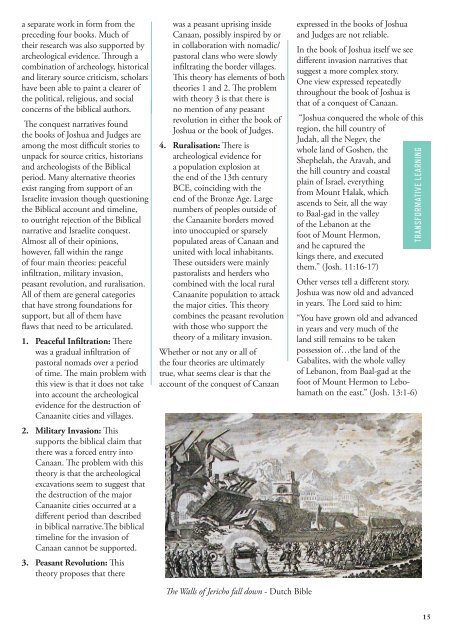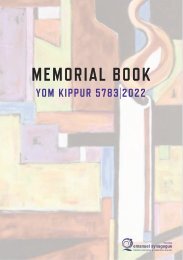Create successful ePaper yourself
Turn your PDF publications into a flip-book with our unique Google optimized e-Paper software.
a separate work in form from the<br />
preceding four books. Much of<br />
their research was also supported by<br />
archeological evidence. Through a<br />
combination of archeology, historical<br />
and literary source criticism, scholars<br />
have been able to paint a clearer of<br />
the political, religious, and social<br />
concerns of the biblical authors.<br />
The conquest narratives found<br />
the books of Joshua and Judges are<br />
among the most difficult stories to<br />
unpack for source critics, historians<br />
and archeologists of the Biblical<br />
period. Many alternative theories<br />
exist ranging from support of an<br />
Israelite invasion though questioning<br />
the Biblical account and timeline,<br />
to outright rejection of the Biblical<br />
narrative and Israelite conquest.<br />
Almost all of their opinions,<br />
however, fall within the range<br />
of four main theories: peaceful<br />
infiltration, military invasion,<br />
peasant revolution, and ruralisation.<br />
All of them are general categories<br />
that have strong foundations for<br />
support, but all of them have<br />
flaws that need to be articulated.<br />
1. Peaceful Infiltration: There<br />
was a gradual infiltration of<br />
pastoral nomads over a period<br />
of time. The main problem with<br />
this view is that it does not take<br />
into account the archeological<br />
evidence for the destruction of<br />
Canaanite cities and villages.<br />
2. Military Invasion: This<br />
supports the biblical claim that<br />
there was a forced entry into<br />
Canaan. The problem with this<br />
theory is that the archeological<br />
excavations seem to suggest that<br />
the destruction of the major<br />
Canaanite cities occurred at a<br />
different period than described<br />
in biblical narrative.The biblical<br />
timeline for the invasion of<br />
Canaan cannot be supported.<br />
3. Peasant Revolution: This<br />
theory proposes that there<br />
was a peasant uprising inside<br />
Canaan, possibly inspired by or<br />
in collaboration with nomadic/<br />
pastoral clans who were slowly<br />
infiltrating the border villages.<br />
This theory has elements of both<br />
theories 1 and 2. The problem<br />
with theory 3 is that there is<br />
no mention of any peasant<br />
revolution in either the book of<br />
Joshua or the book of Judges.<br />
4. Ruralisation: There is<br />
archeological evidence for<br />
a population explosion at<br />
the end of the 13th century<br />
BCE, coinciding with the<br />
end of the Bronze Age. Large<br />
numbers of peoples outside of<br />
the Canaanite borders moved<br />
into unoccupied or sparsely<br />
populated areas of Canaan and<br />
united with local inhabitants.<br />
These outsiders were mainly<br />
pastoralists and herders who<br />
combined with the local rural<br />
Canaanite population to attack<br />
the major cities. This theory<br />
combines the peasant revolution<br />
with those who support the<br />
theory of a military invasion.<br />
Whether or not any or all of<br />
the four theories are ultimately<br />
true, what seems clear is that the<br />
account of the conquest of Canaan<br />
expressed in the books of Joshua<br />
and Judges are not reliable.<br />
In the book of Joshua itself we see<br />
different invasion narratives that<br />
suggest a more complex story.<br />
One view expressed repeatedly<br />
throughout the book of Joshua is<br />
that of a conquest of Canaan.<br />
“Joshua conquered the whole of this<br />
region, the hill country of<br />
Judah, all the Negev, the<br />
whole land of Goshen, the<br />
Shephelah, the Aravah, and<br />
the hill country and coastal<br />
plain of Israel, everything<br />
from Mount Halak, which<br />
ascends to Seir, all the way<br />
to Baal-gad in the valley<br />
of the Lebanon at the<br />
foot of Mount Hermon,<br />
and he captured the<br />
kings there, and executed<br />
them.” (Josh. 11:16-17)<br />
Other verses tell a different story.<br />
Joshua was now old and advanced<br />
in years. The Lord said to him:<br />
TRANSFORMATIVE LEARNING<br />
“You have grown old and advanced<br />
in years and very much of the<br />
land still remains to be taken<br />
possession of…the land of the<br />
Gabalites, with the whole valley<br />
of Lebanon, from Baal-gad at the<br />
foot of Mount Hermon to Lebohamath<br />
on the east.” (Josh. 13:1-6)<br />
The Walls of Jericho fall down - Dutch Bible<br />
15















